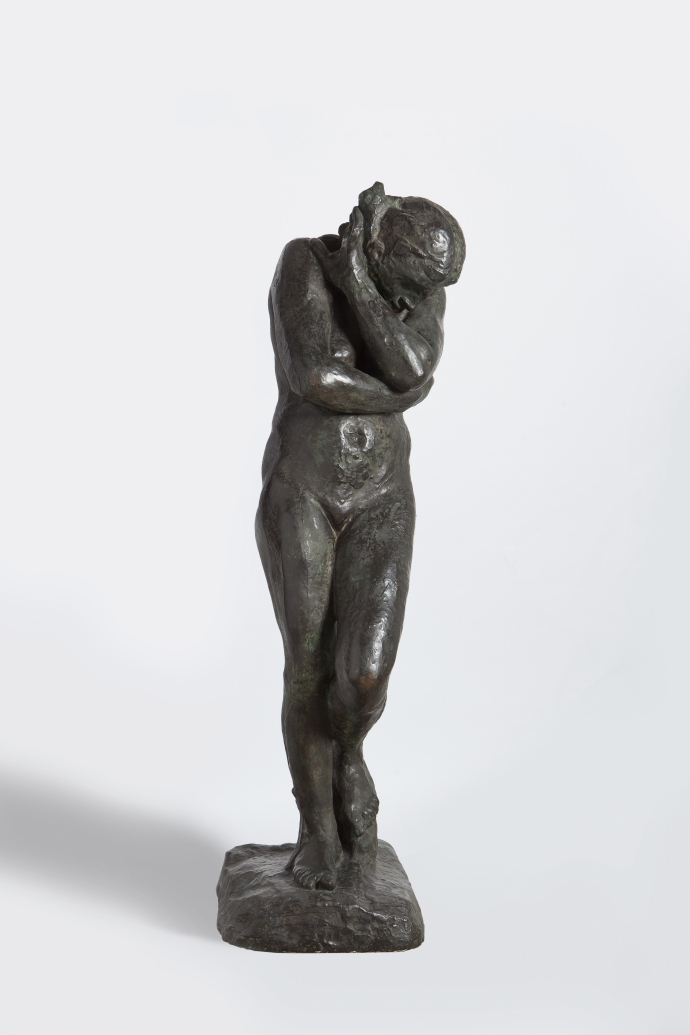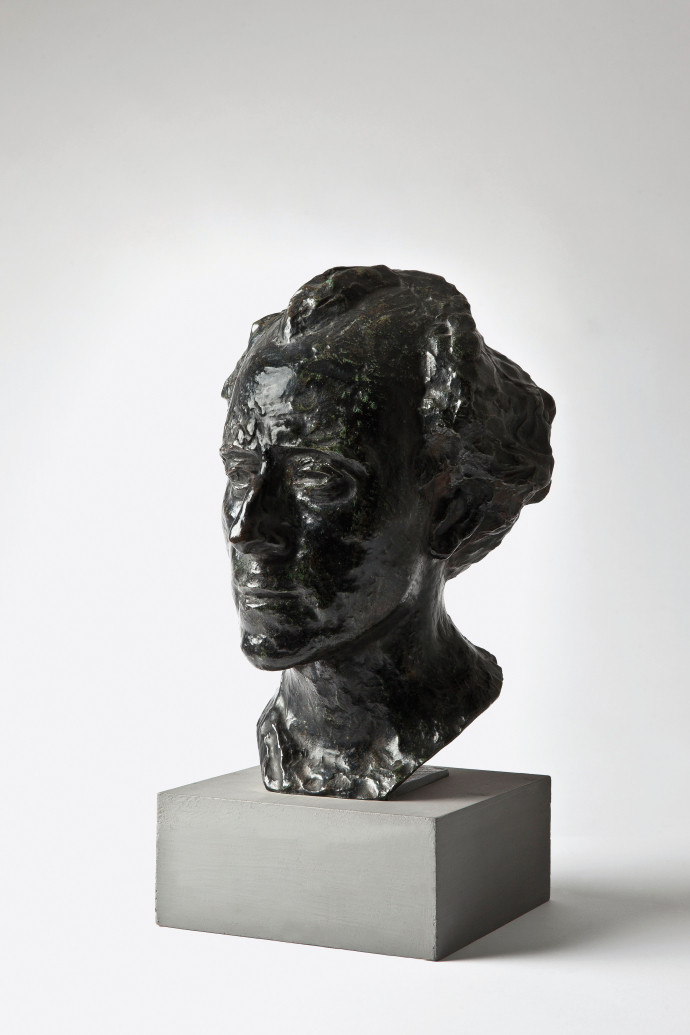nicht ausgestellt
Intro
Auguste Rodin worked on the »Gates of Hell« from 1880 until his death in 1917. It would serve as a sculptural field of experiment for the artist and become his magnum opus. The bronze cast in the possession of the Kunsthalle is based on the third model of the gate (1880) and already points to its later form. The starting point is Dante Alighieri’s (1265–1321) depiction of hell in his »Divine Comedy«, in which the Italian poet staged the depths of human existence—mortality, despair, longing, and loss—in all their emotional breadth. In his treatment of the theme, Rodin interlaces a plethora of figures—originally numbering more than one hundred—which over the years he distributed across the wings of the door and the portal frame in varying combinations. This model displays Rodin’s spontaneous working method, but provides only a mere indication of a major component of his work: namely the dramatically moving bodies, which would become expressions of emotional states. What exists here in draft form would subsequently be worked out in minute detail, including the central figure of »The Thinker«, who reigns gravely over events and is one of Rodin’s most famous individual sculptures.
Background
The »Gates of Hell«, begun in 1880, is the opus magnum within the oeuvre of the French sculptor Auguste Rodin. The bronze portal is six metres high and was commissioned by the French state for the Musée des Arts Décoratifs in Paris, but was never realised. During a creative process which lasted for more than 30 years, the Gates of Hell developed into an autonomous, pure sculpture, for which the Kunsthalle Mannheim possesses a small study model.
In this third and probably final model for the large-scale project, Rodin experimented with the spatial arrangement of the gates and clarified the overall composition of the groups of figures. Modelled originally in clay, then formed in plaster and finally cast in bronze after Rodin’s death, this lifelong experimental work on the Gates of Hell demonstrates a synthesis of Rodin’s sculpture. The artist himself described it as a “Noah’s Ark”, from which a never-ending reservoir of more than 200 sculptures developed, which he isolated as single figures on a number of occasions, varying them in other contexts and in various stages of execution, including »The Thinker«, »The Kiss« and »The Three Shades«.
Within the context of the turn of the century, the »Gates of Hell« belongs to those picture cycles, poems and musical compositions which replaced Christian representations following the secularisation during the nineteenth century. In this work, Rodin created a secular Last Judgement and a permanent symbol of human existence. Based on Dante’s »Divine Comedy«, the Porte de l’enfer conveys the impression of the whirling, falling and plunging of the figures, human melancholy and despair.
“But the movements which he found in the words of the poet belonged to another time; they aroused in the creative artist, who resurrected them, the knowledge of a thousand other gestures – gestures of clutching, losing, suffering and letting go – which had arisen since, and his hands, which knew no fatigue, went on and on, beyond the world of the Florentine poet to ever-new gestures and forms”, Rainer Maria Rilke wrote in 1903 about Rodin’s then still-unfinished life’s work.
Rodin, whose sculptural work extends both formally and with regard to content from Romanticism to Symbolism and Impressionism, described himself as a “bridge linking the two banks of the past and the present”. In the independent development of the artistic means and through his innovative creative approach, which developed out of the work on the »Gates of Hell«, Auguste Rodin acquires programmatic importance as a forerunner of modern sculpture.
On loan from the Friends of the Kunsthalle Mannheim e.V. since 1992; purchased with donations by the members, with special support from Gasversorgung Süddeutschland GmbH, Stuttgart; Badischer Sparkassen- und Giroverband, Mannheim; ÖVA-Versicherungen, Mannheim; Fuchs Petrolub AG, Mannheim; Gisela and Hermann Freudenberg, Weinheim an der Bergstraße; Hans Joachim Deckert, Cologne
![Porte de l'enfer Signatur: bez. auf dem Bronzerahmen links "E. GODARD Fondr" [r ist hochgestellt und unterstrichen], rechts "© MUSEE Rodin 1992 No II/IV" [o ist hochgestellt und 2-fach unterstrichen].](/sites/default/files/styles/960_breit/public/digitalisate/LS187_2020_MOS.jpg?itok=hAoAIH6l)
![Thetis au bouclier Beschriftung recto: u.re.: "Thetis // au bouclier [unleserlich]": Signatur: u.re.: "Aug Rodin": Beschriftung verso: u.li.: "599"; u.mi.: "Auguste Rodin"](/sites/default/files/styles/700_breit/public/digitalisate/G2560_MOS_2017.jpg?itok=b-66V8nJ)
![Weiblicher Rückenakt Beschriftung verso: ohne [Blatt auf Trägerkarton kaschiert]: Signatur: u.li.: "Aug Rodin"](/sites/default/files/styles/700_breit/public/digitalisate/G171_MOS_2018.jpg?itok=nzvKjjsr)
![Figurengruppe Signatur: ohne: Beschriftung verso: [blauer Strich horizontal in der Mitte]](/sites/default/files/styles/700_breit/public/digitalisate/G2896_MOS_2018.jpg?itok=YjnPVAlu)

